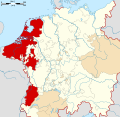Duchy of Luxembourg

- For other uses of Luxembourg see Luxembourg (disambiguation).
The historical region of Luxembourg belonged to the Roman province of Belgica Prima[1]. After the invasion of the Germanic tribes from the East, Luxembourg became part of the Frankish Empire, and was later made part of Middle Francia.
History
Ancient history before 963

The first known reference to the territory in modern Luxembourg was by Julius Caesar in his Commentaries on the Gallic War.[2] Modern historians explain the etymology of the word Luxembourg as coming from the word Letze, meaning fortification [3] which might have referred to either the remains of a Roman watchtower or to a primitive refuge of the early Middle Ages.
County (963-1353)
In the year 963, Count Siegfried of the House of Ardennes purchased some land from the abbot Wikerus of Saint Maximin in Trier. This land was centered around a ruined, supposedly roman, fort by the Germanic name of Lucilinburhuc (which is commonly translated as little castle). In the following years Siegfried had a new castle built on the site of these ruins, on a rock that would later be called Bock Fiels. This castle dominated a stretch of the old roman road linking Reims, Arlon and Trier, which also opened some prospects for trade and taxation. Despite this new construction it seems that Siegfried and his immediate successors did not make the castle their primary residence. The history of Luxembourg proper began with the construction of this castle.
In following years, a small town and market grew around the new castle. The first inhabitants were probably servants of count Siegfried and clergy of Saint Michael's church. This settlement soon received additional protection by the construction of a first, partial city wall and moat.
In addition to the small town near Bock Fiels and the roman road, another settlement was formed in the Alzette Valley (today the Grund quarter). By 1083 this lower town contained two churches, two bridges of the rivers Alzette and Petruss. Its inhabitants pursued various professions including fishery, bakers and millers. That same year the Benedictine abbey of Altmünster was founded by count Conrad on the hill behind Luxembourg castle.
Henry III was the first count known to have established his permanent residence in Luxembourg castle. In a document from the year 1089 he is referred to as comes Henricus de Lutzeleburg, which also makes him the first documented count of Luxembourg.
Around this fort, the town gradually developed, which became the centre of a small but important state of great strategic value to France, Germany and the Low Countries. Luxembourg's fortress, was steadily enlarged and strengthened over the years by successive owners, which made it one of the strongest fortresses on the European continent. Its formidable defences and strategic location caused it to become known as the Gibraltar of the North.
The House of Luxembourg provided several Holy Roman Emperors, Kings of Bohemia, as well as Archbishops of Trier and Mainz. From the early Middle Ages to the Renaissance, Luxembourg bore multiple names, depending on the author. These include Lucilinburhuc, Lutzburg, Lützelburg, Luccelemburc, Lichtburg, among others.
Duchy (1353-1790)

Luxembourg remained an independent fief (county) of the Holy Roman Empire until 1354, when the emperor Charles IV elevated it to the status of a duchy for his brother Wenceslaus. The duchy of Luxembourg was formed in 1353 by integration of the old county of Luxembourg, the marquisat of Arlon, the counties of Durbuy and Laroche as well as the districts of Thionville, Bitburg and Marville. The county of Vianden can also be included as it had been a vassal of the counts and dukes of Luxembourg since about July 31, 1264.
The Duchy passed to the Dukes of Burgundy of the House of Valois, and to the Archduke of Austria of the House of Habsburg. The Seventeen Provinces were formed into an integral union by Charles V, Holy Roman Emperor in the Pragmatic Sanction of 1549.
In 1792, French revolutionaries ended this situation. Only at the Congress of Vienna in 1815 this situation was resolved, as the Duchy of Luxembourg was upgraded to a Grand Duchy, and given to William I of the Netherlands in a personal union with the United Kingdom of the Netherlands.
Grand duchy (1815-Present)
Rulers
and Prime Ministers of Luxembourg
See also
- Counts, Dukes and Grand Dukes of Luxembourg
- History of Luxembourg
- Grand Ducal Family of Luxembourg
- Prime Ministers of Luxembourg
- Coat of arms of Luxembourg
References
- ^ "Luxembourg." Funk & Wagnalls New Encyclopedia, 16. Funk & Wagnalls, Inc., 1990. ISBN 0-8343-0091-5
- ^ "Luxembourg". Catholic Encyclopaedia. 1913. Retrieved 2006-07-30.
- ^ J.-P. Koltz, Baugeschichte der Stadt und Festung Luxemburg, I. Band
- Ermesinde et l'affranchissement de la ville de Luxembourg; Etudes sur la femme, le pouvoir et la ville au XIIIe siècle, sous la direction de Michel Margue, Publications du Musée d'Histoire de la Ville de Luxembourg, Publications du CLUDEM tome 7, Luxembourg 1994.
- Tatsachen aus der Geschichte des Luxemburger Landes, Dr. P. J. Müller, Luxemburg 1963, Verlag "de Frendeskres", Imprimerie Bourg-Bourger.
- Vivre au Moyen Age: Luxembourg, Metz et Trèves; Etudes sur l'histoire et l'archéologie urbaines, sous la direction du Musée d'Histoire de la Ville de Luxembourg, Publications Scientifiques du Musée d'Histoire de la Ville de Luxembourg, tome 2, Luxembourg 1998.




